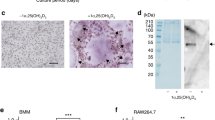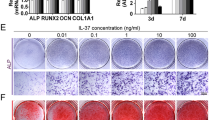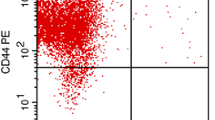Abstract
Tumor necrosis factor-alpha (TNF -ga), a 17-kDa cytokine produced by stimulated macrophages/monocytes, modulates the functions of a variety of cells and has been shown to induce bone resorption in vitro. However, the effects that TNF-α may have on the process of bone formation are not completely understood. In order to study the effects of TNF-α on matrix development and mineralization, we utilized a human osteoblastic cell line, HOS TE85. Our results show that HOS TE85, which has been shown to be responsive to hormones active on normal osteoblasts, forms an extensive extracellular matrix (ECM) that mineralizes during extended culture. Treatment during the development of the matrix with TNF-α has little effect on cell number and DNA synthesis, showing thereby that TNF-α is not cytotoxic to the cells. However, TNF-α inhibits the formation of alkaline phosphatase (AP) -positive foci in a dose-dependent manner at concentrations of 0.1–10 ng/ml. TNF-α treatment caused a significant decrease in the incorporation of collagen into the developing matrix. In addition, TNF-α treatment resulted in a significant decrease in the synthesis of AP by HOS TE85 cells during the process of ECM formation and resulted in a pronounced lack of mineralization of the ECM. These results indicate that TNF-α may be acting as an uncoupler by decreasing the synthesis and incorporation of proteins required for bone formation, and inhibiting matrix formation and mineralization in vitro.
Similar content being viewed by others
References
McSheehy, P. M. J., andT. J. Chambers. 1986. Osteoblastic cells mediate osteoclastic responsiveness to parathyroid hormone.Endocrinology 118:824–828.
McSheehy, P. M. J., andT. J. Chambers. 1987. Dihydroxyvitamin D3stimulates rat osteoblastic cells to release a soluble factor that increases osteoclastic bone resorption.J. Clin. Invest. 80:425–429.
Joyce, M. E., S. Jingushi, andA. B. Roberts. 1989. Transforming growth factor-beta initiates cartilage and bone formation in vivo.J. Bone Min. Res. 4:S259.
Beresford, J. N., G. T. Taylor, andJ. T. Triffitt. 1990. Interferons and bone: A comparison of the effects of interferon-α and interferon-γ in cultures of human bone derived cells and an osteosarcoma cell line.Eur. J. Biochem. 193:589–597.
Thomson, B. M., J. Saklatvala, andT. J. Chambers. 1986. Osteoblasts mediate interleukin-1 stimulated bone resorption by rat osteoclasts.J. Exp. Med. 164:104–112.
Ishimi, Y., C. Miyaura, C. H. Jin, T. Akatsu, E. Abe, Y. Nakamura, A. Yamaguchi, S. Yoshiki, T. Matsuda, T. Hirano, T. Kishimoto, andT. Suda. 1990. IL-6 is produced by osteoblasts and induces bone resorption.J. Immunol. 145:3297–3303.
Stashenko, P., M. S. Obernesser, andF. E. Dewhirst. 1989. Effects of immune cytokines on bone.Immunol. Invest. 18:239–249.
Bertolini, D. R., G. E. Nedwin, T. S. Bringman, D. D. Smith, andG. R. Mundy. 1986. Stimulation of bone resorption and inhibition of bone formation in vitro by human tumor necrosis factors.Nature 319:516–518.
Pfeilschifter, J., C. Chenu, A. Bird, G. R. Mundy, andG. D. Roodman. 1989. Interleukin-1 and tumor necrosis factor stimulate the formation of human osteoclastic-like cells in vitro.J. Bone Min. Res. 4:113–118.
Vaes, G. 1988. Cellular biology and biochemical mechanism of bone resorption.Clin. Orthop. Relat. Res. 231:239–271.
Jones, P. A., J. S. Rhim, H. Issacs, andR. M. McAlister. 1975. Relationship between tumorigenicity, growth in agar and fibrinolytic activity in a line of human osteosarcoma cells.Int. J. Cancer 16:616–621.
Guo, J. Z., andH. G. Friesen. 1991. The osteoblastic properties of human osteogenic sarcoma cell line HOS TE85 characterized by morphological, histochemical and molecular biological studies.J. Bone Min. Res. 6:S203.
Kissane, J. M., andE. Robins. 1958. The fluorometric measurement of DNA in animal tissues with respect to the central nervous system.J. Biol. Chem. 233:184–188.
Lowry, O. H., N. R. Roberts, M.-L. Wu, W. S. Hixon, andE. J. Crawford. 1953. The quantitative histochemistry of brain; enzyme measurements.J. Biol. Chem. 207:19–37.
McGee-Russell, S. M. 1958. Histochemical methods for calcium.J. Histochem. Cytochem. 6:22–42.
Peterkofsky, B., andD. Diegelmann. 1971. Use of a mixture of proteinase-free collagenase for the specific assay of radioactive collagen in the presence of other proteins.Biochemistry 6:988–994.
Chomczynski, P., andN. Sacchi. 1989. Single-step method of RNA isolation by guanidinium thiocyanate-phenol-chloroform extraction.Anal. Biochem. 163:156–162.
Aubin, J. E., N. M. Heersche, M. J. Merrilees, andJ. Sodek. 1982. Isolation of bone cell clones with differences in growth, hormone responses, and extracellular matrix production.J. Cell. Biol. 92:452–461.
Bellows, C. G., J. E. Aubin, N. M. Heersche, andM. E. Antosz. 1986. Mineralized bone nodules formed in vitro from enzymatically released rat calvaria cell populations.Calcif. Tissue Int. 38:143–154.
Sudo, H., H.-A. Kodama, Y. Amagai, S. Yamamoto, andS. Kasai. 1983. In vitro differentiation and calcification in a new clonal osteogenic cell line derived from newborn mouse calvaria.J. Cell. Biol. 96:191–198.
Escarot-Charrier, B., F. H. Glorieux, M. van der Rest, andG. Pereira. 1983. Osteoblasts isolated from mouse calvaria initiate matrix mineralization in culture.J. Cell Biol. 96:639–643.
Tenenbaum, H. C., andJ. N. M. Heersche. 1982. Differentiation of osteoblasts and formation of mineralized bone in vitro.Calcif. Tissue Int. 34:76–79.
Gerstenfeld, L. C., S. D. Chipman, C. M. Kelley, K. J. Hodgens, D. D. Lee, andW. J. Landis. 1988. Collagen expression, ultrastructural assembly and mineralization in cultures of chicken embryo osteoblasts.J. Cell Biol. 106:979–989.
Shaloub, V., L. C. Gerstenfeld, D. Collart, J. B. Lian, andG. S. Stein. 1989. Down-regulation of cell growth and cell cycle regulated genes during chick osteoblast differentiation with the reciprocal expression of histone gene variants.Biochemistry 28:5318–5322.
Guenther, H. L., M. G. Cecchini, P. R. Elford, andH. Fleisch. 1988. Effects of transforming growth factor type beta upon bone cell populations grown either in monolayer or semisolid medium.J. Bone Min. Res. 3:269–278.
Centrella, M., T. L. McCarthy, andE. Canalis. 1987. Mitogenesis in fetal rat bone cells simultaneously exposed to type beta transforming growth factor and other growth regulators.FASEB J. 1:312.
Rosenblum, M. G., andN. J. Donato. 1989. Tumor necrosis factor a: A multifaceted peptide hormone.Crit. Rev. Immunol. 9:21–44.
Beresford, J. N., J. A. Gallagher, andR. G. G. Russell. 1986. 1,25-Dihydroxyvitamin D3 and human bone-derived cells in vitro: Effects on alkaline phosphatase, type I collagen and proliferation.Endocrinology 119:1776–1785.
Linkhart, S., S. Mohan, T. A. Linkhart, W. Kumagawa, andD. J. Baylink. 1986. Human skeletal growth factor stimulates collagen synthesis and inhibits proliferation in a clonal osteo-blastic cell line (MC3T3-E1).J. Cell. Physiol. 128:307–312.
Strong, D. D., J. E. Wegedal, A. L. Beachler, S. Mohan, T. A. Linkhart, andD. J. Baylink. 1988. Transforming growth factor beta increases type I collagen message in cultured normal human bone cells.FASEB 2:A842.
Wergedan, J. E., S. Mohan, M. Lundy, andD. J. Baylink. 1990. Skeletal growth factors known to be present in bone matrix stimulate proliferation and protein synthesis in human bone cells.J. Bone Min. Res. 5:179–186.
Meikle, M. C., S. J. Atkinson, R. V. Ward, G. Murphy, andJ. J. Reynolds. 1989. Gingival fibroblasts degrade type I collagen films when stimulated with tumor necrosis factor and interleukin 1: Evidence that breakdown is mediated by metalloproteinases.J. Periodont. Res. 24:207–213.
Panagakos, F. S., and S.Kumar. 1993. Modulation of proteases in a human osteosarcoma cell line by tumor necrosis factor-alphaInflammation (in press).
Author information
Authors and Affiliations
Rights and permissions
About this article
Cite this article
Panagakos, F.S., Hinojosa, L.P. & Kumar, S. Formation and mineralization of extracellular matrix secreted by an immortal human osteoblastic cell line: Modulation by tumor necrosis factor-alpha. Inflammation 18, 267–284 (1994). https://doi.org/10.1007/BF01534268
Issue Date:
DOI: https://doi.org/10.1007/BF01534268




